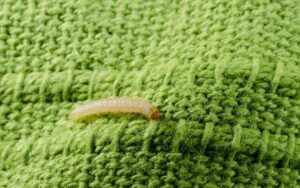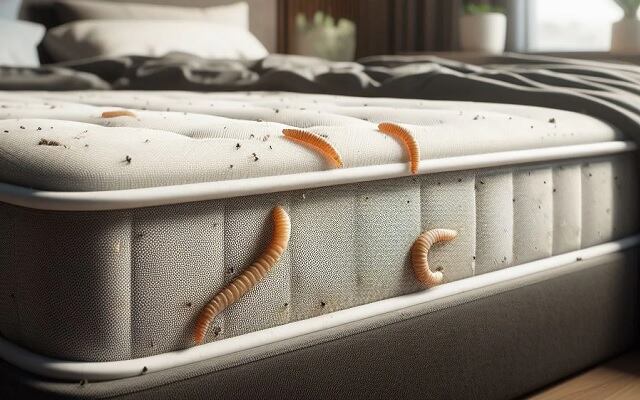Bed Worms: Identification, Prevention, and Treatment
Bed worms are a lesser-known but significant nuisance that can affect your comfort and health. Understanding these pests is crucial to maintaining a clean and pest-free home. In this article, we will explore everything you need to know about bed worms, including their identification, causes, prevention, and treatment.
What Are Bed Worms?
Definition of Bed Worms
The term “bed worms” refers to the larvae of various insects that can infest bedding, mattresses, and furniture. These larvae are not a specific species but can come from different insects such as carpet beetles, clothes moths, or even bed bugs. They thrive in warm, humid environments and feed on natural fibers, which makes your bed an ideal habitat.
Common Types of Bed Worms
- Carpet Beetle Larvae: These are among the most common types of bed worms. They are small, hairy, and can vary in color from light brown to black.

- Clothes Moth Larvae: These larvae are small, white, and often found in woolen fabrics.

- Bed Bug Nymphs: Although not typically referred to as worms, bed bug nymphs can be mistaken for bed worm due to their size and shape.

Identifying Bed Worms
Physical Characteristics
Identifying bed worms involves looking for small, worm-like creatures in your bed and surrounding areas. Here are some key characteristics:
- Size: Bed worms are usually between 1/8 to 1/4 inch long.
- Color: They can be white, brown, or black.
- Shape: Most bed worms are elongated with segmented bodies.
Signs of Infestation
In addition to spotting the worms themselves, look for other signs of an infestation:
- Silk Threads: Some larvae, like clothes moth larvae, leave behind silk threads.
- Frass: This is the fecal matter of larvae, often appearing as small pellets or powder.
- Damage: Holes or damage in fabrics and bedding can indicate the presence of larvae.
Differences Between Bed Worms and Other Pests
It’s important to distinguish bed worms from other pests like bed bugs or dust mites:
- Bed Bugs: Bed bugs are reddish-brown, flat, and oval-shaped. Their nymphs look similar but are more mobile and feed on blood.
- Dust Mites: These are microscopic and not visible to the naked eye. They do not leave visible signs like larvae do.
Causes and Risk Factors
Factors Attracting Bed Worms
Bed worms are attracted to certain conditions and materials:
- Food Sources: Natural fibers like cotton, wool, and silk are prime food sources.
- Moisture: High humidity levels provide a conducive environment for larvae to thrive.
- Warmth: Bed worm prefer warm environments, which is why they are often found in bedding.
Entry Points
Bed worm can enter your home through various means:
- Open Windows and Doors: Insects can fly or crawl in, laying eggs that develop into larvae.
- Pets: Pets can carry insects and their larvae into the home.
- Luggage and Second-Hand Items: Infested items can introduce bed worms into your living space.
Risk Factors for Infestation
Certain habits and conditions increase the risk of bed worm infestations:
- Clutter: A cluttered home provides more hiding places for insects to lay eggs.
- Infrequent Cleaning: Not cleaning regularly allows larvae to develop undisturbed.
- Improper Storage: Storing clothes and linens in damp or unsealed conditions can attract bed worms.
Prevention Tips
Regular Cleaning and Vacuuming
Maintaining a clean home is the first step in preventing bed worm infestations:
- Vacuum Regularly: Pay special attention to carpets, rugs, and upholstered furniture.
- Wash Bedding Frequently: Use hot water to kill any larvae or eggs.
Proper Storage of Clothes and Linens
Storing your items correctly can prevent infestations:
- Sealed Containers: Store clothes and linens in airtight containers to keep pests out.
- Dry Storage: Ensure storage areas are dry and well-ventilated to prevent moisture buildup.
Reducing Humidity and Moisture Levels
Keeping humidity levels low discourages larvae from thriving:
- Dehumidifiers: Use dehumidifiers in damp areas of your home.
- Proper Ventilation: Ensure good airflow in all rooms, especially closets and storage areas.
Inspecting Second-Hand Furniture and Clothes
Always check second-hand items before bringing them into your home:
- Thorough Inspection: Look for signs of larvae or eggs on furniture and clothes.
- Cleaning: Wash and vacuum items thoroughly before use.
Using Protective Covers for Mattresses and Pillows
Protective covers can prevent larvae from infesting your bedding:
- Encasements: Use encasements designed to keep bed bugs and larvae out.
- Regular Washing: Wash covers regularly to remove any potential pests.
Treatment and Removal
DIY Methods for Treating Bed Worm Infestations
There are several home remedies you can try to eliminate bed worms:
- Thorough Cleaning and Vacuuming: Regular cleaning disrupts the life cycle of the larvae.
- High-Temperature Washing: Wash all affected fabrics in hot water to kill larvae and eggs.
- Natural Repellents: Essential oils like lavender, eucalyptus, and cedarwood can repel bed worms.
Commercial Treatments and Insecticides
If DIY methods are not enough, consider commercial treatments:
- Insecticides: Use insecticides specifically designed for indoor use and follow the instructions carefully.
- Professional Products: Consider professional-grade products for severe infestations.
When to Call a Professional Exterminator
In some cases, professional help may be necessary:
- Persistent Infestations: If the infestation persists despite your efforts, a professional can provide more effective solutions.
- Severe Infestations: Large-scale infestations may require specialized treatments that only professionals can offer.
Long-term Management and Monitoring
Regular Inspection of Common Infestation Areas
Keep an eye on areas where bed worms are likely to appear:
- Bedding and Mattresses: Regularly inspect these areas for signs of larvae.
- Closets and Storage Areas: Check for larvae in clothing and linens stored away.
Continued Preventive Measures
Consistently applying preventive measures can keep bed worms at bay:
- Ongoing Cleaning: Maintain a regular cleaning schedule to prevent re-infestation.
- Proper Storage: Continue to store items in sealed, dry conditions.
How to Monitor for Signs of Re-infestation
Stay vigilant for any signs that bed worms have returned:
- Regular Checks: Periodically inspect your home for larvae or damage.
- Pest Traps: Use traps to monitor for the presence of insects that could lay eggs.
Keeping a Pest-Free Home Environment
A clean and well-maintained home is less likely to have pest problems:
- Routine Maintenance: Regularly clean and declutter your home.
- Proper Hygiene: Maintain good hygiene practices to minimize attractants for pests.
Common Myths and Misconceptions
Clarifying Common Myths About Bed Worms
There are several myths about bed worms that need clarification:
- Myth: Bed Worms Are the Same as Bed Bugs: Bed worms are larvae of various insects, not bed bugs.
- Myth: Bed Worms Only Infest Dirty Homes: Even clean homes can be infested if the conditions are right.
Providing Accurate Information to Dispel Misconceptions
Accurate information helps in dealing with bed worms effectively:
- Identification: Properly identifying the type of larvae is crucial for effective treatment.
- Prevention: Understanding the causes and prevention methods can significantly reduce the risk of infestation.
Importance of Proper Identification for Effective Treatment
Knowing what you’re dealing with is the first step to solving the problem:
- Correct Identification: Identifying the specific type of larvae ensures you use the right treatment methods.
- Tailored Solutions: Different larvae may require different approaches for effective removal.
Conclusion
Understanding bed worms, their causes, and how to prevent and treat infestations is essential for maintaining a comfortable and healthy living environment. Regular cleaning, proper storage, and vigilance are key to keeping these pests at bay. By taking proactive measures and staying informed, you can ensure that your home remains free from bed worms and other pests.
Also Visit Bedding Expertise for more valueable information on bedding topics!
